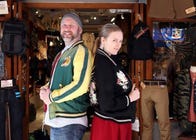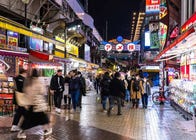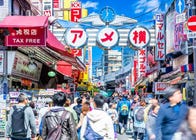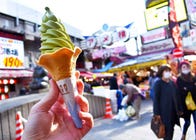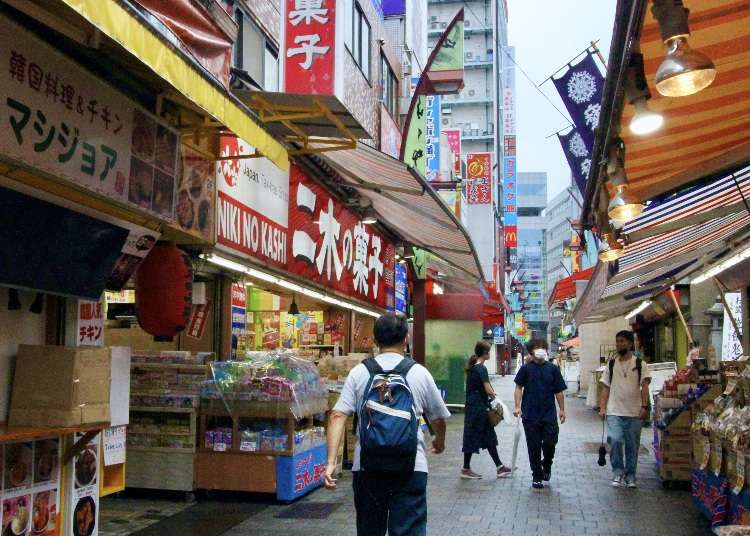
The Ultimate Guide to Ueno (Tokyo): From Cherry Blossoms to Pandas
- Written by: Cassandra Lord
Ueno is a fun yet underrated area in East Tokyo, with the spacious Ueno Park and museums to one side of the JR station and plenty of shops and restaurants to the other.
While Ueno Park is well-known for its beautiful cherry blossoms in spring, it can get pretty crowded, so let's look at some of the other things you can do all year round in Ueno!
Ueno Overview
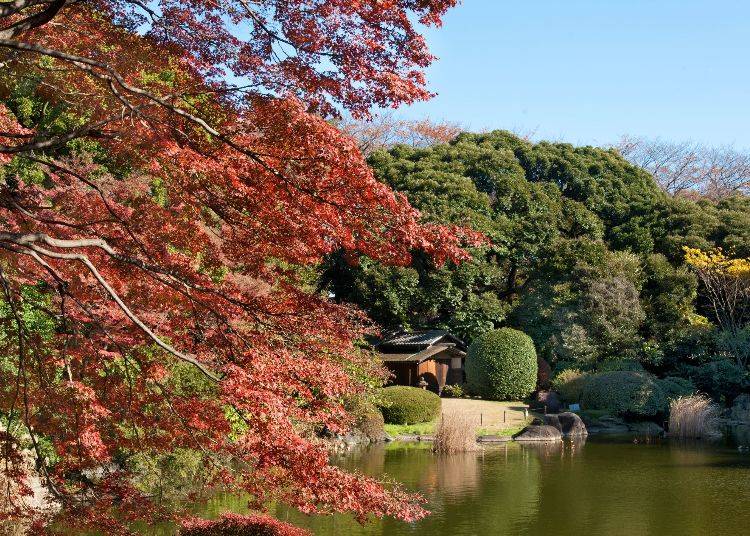
Ueno is an exciting area, because depending on which side of the JR station you exit from, you could find yourself walking among green trees and cultural spots, or exploring a concrete jungle of hidden shops and eateries.
Exiting Ueno JR Station via the Park Exit will place you right outside The National Museum of Western Art, Japan's only national museum dedicated to Western artworks. Wander further north through the park and past the giant fountains to find the Tokyo National Museum. Or, go southwest through the park to find the lotus pond, with Bentendo Temple and the Shitamachi Museum beside it.
If you're spending a day in Ueno exploring its culture, there are plenty of options for food or shopping breaks in between on the other side of the station. Exiting from the Central Ticket Gate, you'll see the Hard Rock Cafe to your left, right within the station complex. Venture out, and you'll soon find the famous Ameyoko shopping street, filled with interesting market-like souvenir and food shops. There lies the sukajan jacket shop, Hinoya One, as well as the famous Niki no Kashi sweets shop. Further afield, there are interesting brunch spots and cafes like Egg Baby Café and Usagiya Café.
Interested yet? Let's take a look at what to do on a day out in Ueno.
Attractions and Activities in Ueno
Bentendo Temple
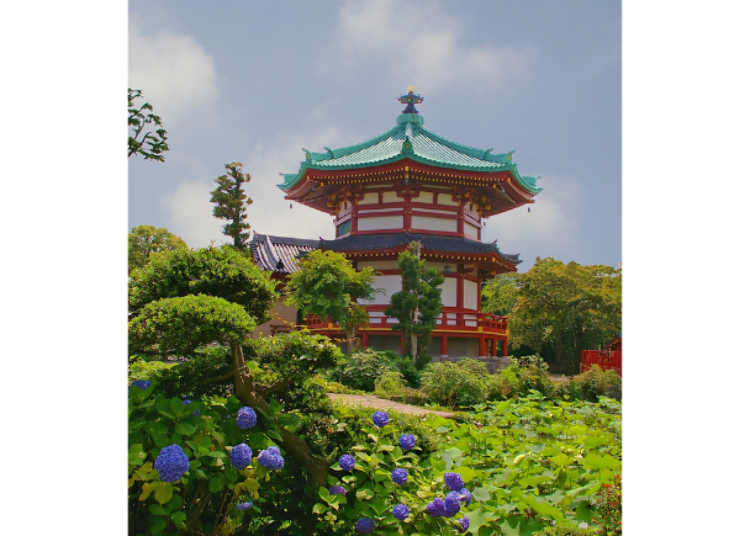
Also known as Shinobazu Pond Bentendo Temple, this is one of the many temples and shrines you can find around Ueno Park, which each have their own different characteristics.
The octagonal Bentendo Temple overlooking the beautiful lotus pond was originally built in the early Edo period (1536-1643). The area was originally likened to that of Japan's largest lake, Lake Biwa, right down to the small island with a temple on it. So, Bentendo Temple was created as an homage. People originally visited by boat, but due to its popularity, a bridge was added.
After it was burnt down along with many other areas of Tokyo in 1945, it was rebuilt in 1958. Shortly after, an esteemed artist named Kibo Kodama added the majestic dragon artwork to its ceiling.
Benzaiten is worshipped as a guardian of music at Bentendo Temple, as well as for financial fortune. You can see Benzaiten's likeness once a year in September at their Minarukane festival. But there are other festivals held throughout the year, too. Depending on when you visit, you might find various food stalls and festivities await!
-

-
Address
2-1, Uenokouen, Taitou-ku, Tokyo, 110-0007
View Map -
Nearest Station
Ueno Station (Hokkaido Shinkansen Line / Tohoku Shinkansen Line / Akita Shinkansen Line / Yamagata Shinkansen Line / Joetsu Shinkansen Line / Hokuriku Shinkansen Line / JR Keihin-Tohoku Line / JR Yamanote Line / JR Tohoku Main Line / JR Utsunomiya Line / JR Takasaki Line / JR Joban Line / JR Ueno Tokyo Line / Tokyo Metro Ginza Line / Tokyo Metro Hibiya Line)
8 minutes on foot
- Phone Number 03-3821-4638
-
Address
2-1, Uenokouen, Taitou-ku, Tokyo, 110-0007
Tokyo National Museum
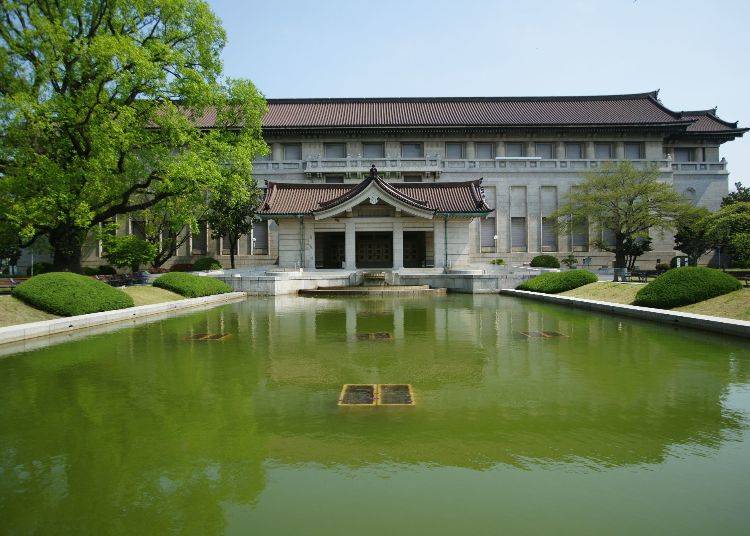
The Tokyo National Museum collects and preserves cultural properties from around Japan and Asia, but of course, with a focus on Japan.
The museum was established in 1872, making it the oldest museum of its kind in Japan, and was originally called the "Museum of the Ministry of Education". It went through a few name changes over the years before settling on the Tokyo National Museum. It also went though some structural changes, as the current "Honkan" or main building, was reopened in 1938 after the Great Kanto Earthquake toppled the original building.
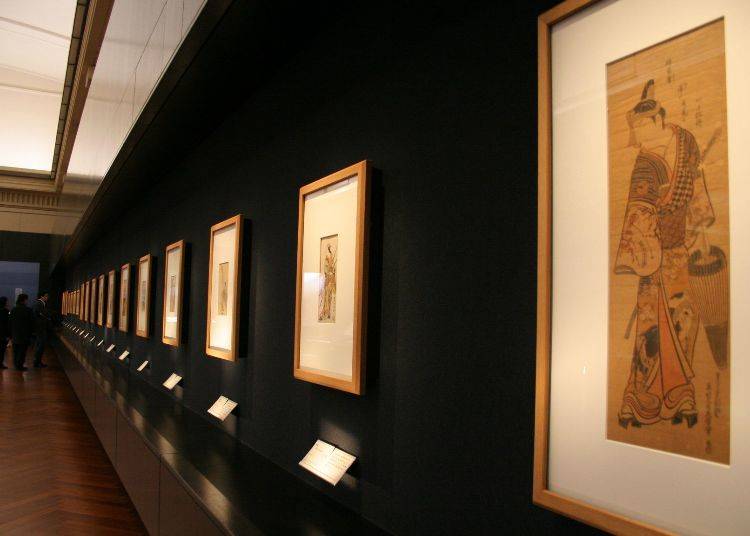
In the Honkan (Japanese Gallery) on the second floor you'll find the chronological exhibition of Japanese arts, with works from the Jomon to the Edo period, including sculptures, paintings, ceramics, and swords. In the Toyokan, there is the Asian Gallery, housing art and archaeological artefacts from other Asian regions including China and the Korean peninsula.
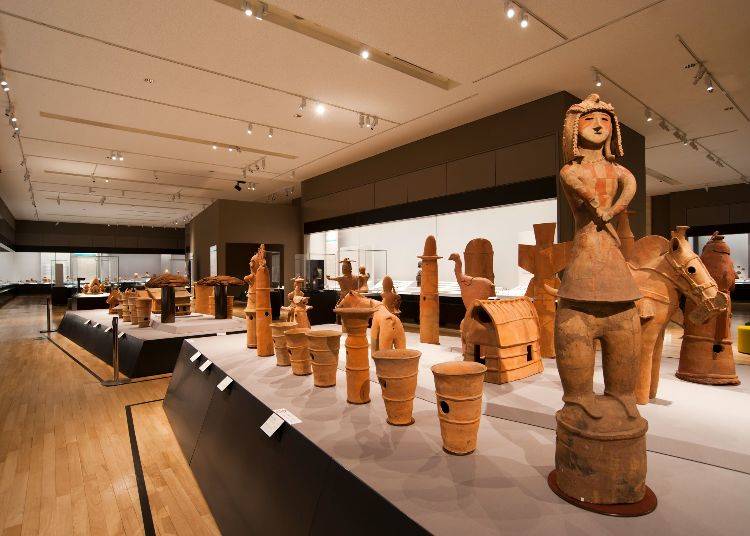
For clay figures and bronzework from further back in time, the Heiseikan is an interesting peek into history. There are plenty of interesting historical works to explore in the other buildings too, such as the Hyokeikan or Kuroda Memorial Hall.
If you want to get a bite to eat, there are currently three options for food: the Hotel Okura Yurinoko, and the Tulip Tree Café. Or, for some souvenirs, the museum shop sells everything from small postcards to large recreations of the masterpieces. So you can take a little piece of your favorite work back with you.
The Tokyo National Museum aims to play a central role in disseminating Japanese culture to the rest of the world, so they take measures to make the experience more accessible to non-Japanese visitors by providing exhibition commentary and multilingual support in various languages.
Multilingual Support:
Multilingual support (hardware); Multilingual support (software, staff availability, etc.); Multilingual support (dissemination of information such as HP and SNS); English available for phone services; Free Wi-Fi; Credit card payment support (including UnionPay); Existence of smoke separation and smoking space; Nursing room available; Support for dietary and religious requirements; Support for contactless payment
Health & Safety Measures:
Indoor disinfection measures taken; Sanitizer installed; Disinfected periodically; Ventilation measures in place; Coin trays used; Plastic partitions installed; Staff wear masks, gargle, wash hands regularly, and monitor body temperature; Limited capacity/increased space between seats; Entry declined to anyone who is feeling unwell; Guests requested to wear masks and conduct temperature checks
-
Tokyo National Museum東京国立博物館
- Address 13-9 Ueno Park, Taito City, Tokyo 110-8712
TEL: 050-5541-8600 (Hello Dial)
・Hours: 9:30 a.m. – 5:00 p.m.
・Closed: Mondays
・Website: <a href="https://www.tnm.jp/">https://www.tnm.jp/</a>
・Entry: 1,000 yen (500 yen for students)
The National Museum of Western Art
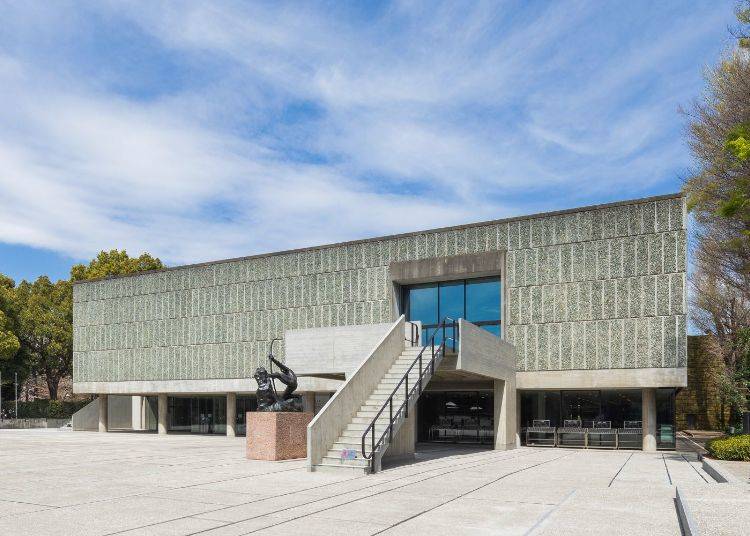
Where the Tokyo National Museum focuses on Japanese and Asian pieces, The National Museum of Western Art focuses on Western, and mainly European, artworks.
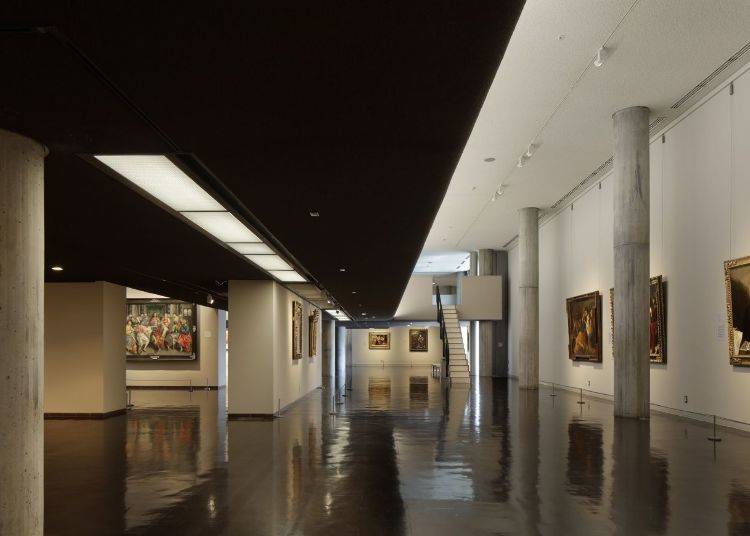
The museum started with an art collection brought together by Kojiro Matsukata. Having amassed significant wealth from his shipbuilding business, he procured a huge number of artworks from around Europe. His intention was always to showcase the works in a gallery or museum in Japan, to give Japanese citizens the opportunity to study them. He was due to build the museum in Tokyo, but due to the economic crisis of 1927, had to sell the works he had in Japan. About 400 of his collected works remained in France. These were sequestered as enemy property for a time due to WWII, but were eventually returned to the Japanese government as a sign of renewed amity, and were dubbed the Matsukata Collection. This was the start of The National Museum of Western Art, which opened in 1959.
Now, as well as the Matsukata Collection, the museum also showcases works from the Middle Ages to the 20th century which were acquired after opening. These are all part of the permanent collection displayed in the Main Building and New Wing.
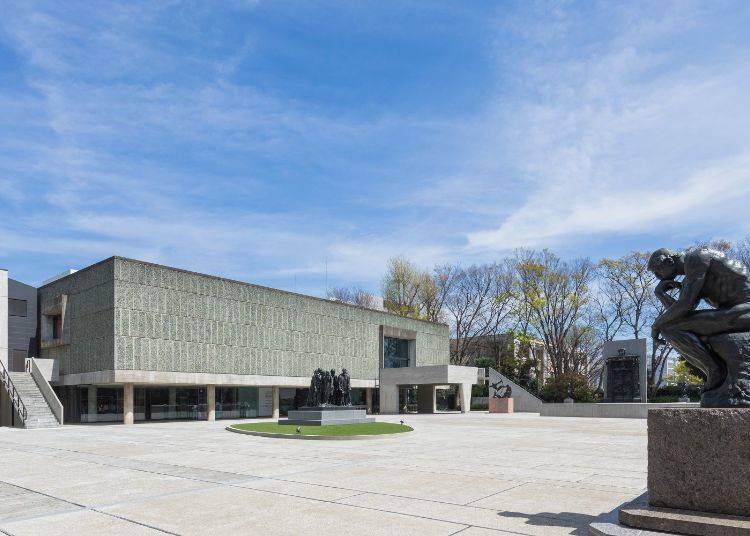
As you enter the museum grounds, you'll notice several bronze sculptures in the forecourt. These are the works of Auguste Rodin, and include pieces such as the famous 'The Thinker (Enlarged)'. The piece you see here was enlarged by Rodin's collaborator Henri Lebossé.
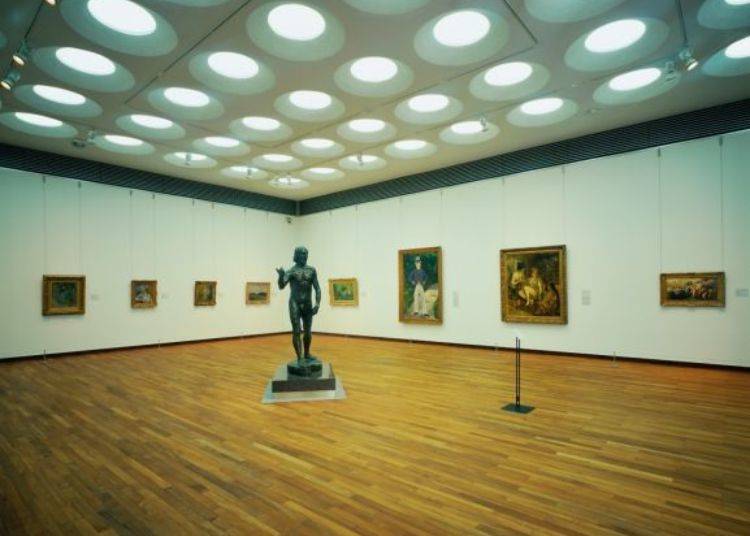
Inside the museum are around 6,000 works of art, housing paintings and sculpture from the 14th to the 20th century. The museum features well-known names such as Vincent Van Gogh, Claude Monet, and Paul Cézanne. Marvel at Monet's Water Lilies, or lose yourself in Van Gogh's roses.
For a bit of a break, their light and airy café offers serene views alongside a light bite or a full lunch. Sample their desserts and drinks, or settle in for a pasta or mixed plate. And don't forget to stop by the modest gift shop filled with stationery and educational books.
Multilingual support:
Website available in various languages.
Health & Safety Measures:
Indoor disinfection measures taken; Sanitizer installed; Disinfected periodically; Ventilation measures in place; Coin trays used; Plastic partitions installed; Staff wear masks, gargle, wash hands regularly, and monitor body temperature
-
The National Museum of Western Art国立西洋美術館
- Address 7-7 Ueno-koen, Taito-ku, Tokyo 110-0007
-
Nearest Station
・JR Ueno Station (3 min. walk from the Park Exit)
・Tokyo Metro Ginza Line (8 min. walk)
・Tokyo Metro Hibiya Line (8 min. walk)
・Keisei Ueno Station (7 min. walk)
・Hours: 9:30 a.m. – 5:30 p.m. (until 8:00 p.m. on Fridays and Saturdays) (Entry up to 30 minutes before closing)
・Closed: Mondays (Open on public holidays, closed the day after.) Closed for New Year (December 28 – January 1).
・Website: <a href="https://www.nmwa.go.jp/en">https://www.nmwa.go.jp/en</a>
・TEL: 050-5541-8600 (Hello Dial)
Shitamachi Museum
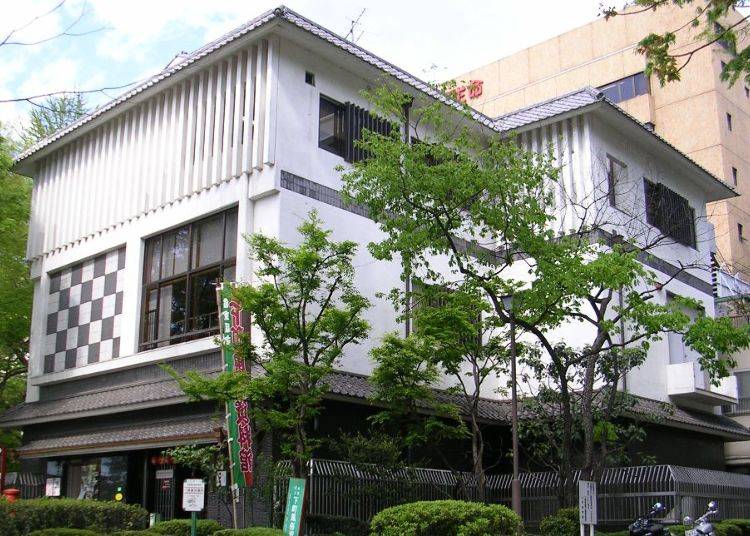
On the southeastern edge of the lotus pond of Ueno Park, you'll find the Shitamachi Museum. The museum gives an insight into what life was like in the Tokyo shitamachi areas from 1868-1964.
So what does "shitamachi" mean? The word is sometimes translated as "downtown", but basically refers to an area where the working class lived, usually in a castle town.
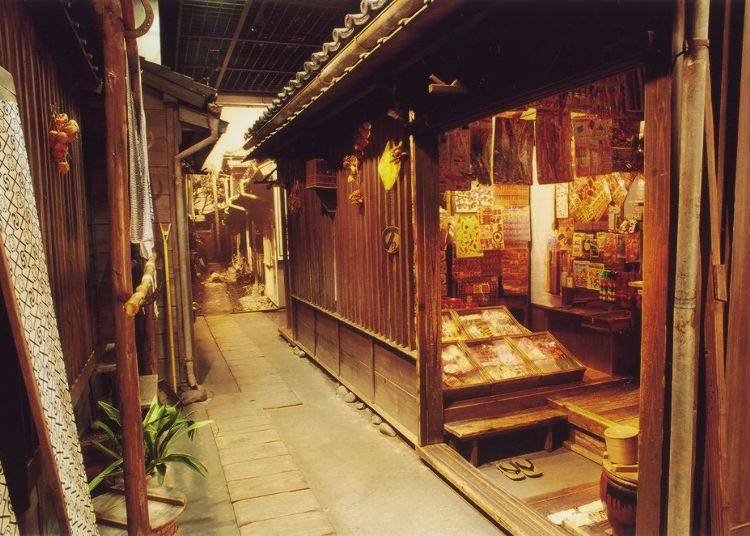
Kondo-san, a researcher at the museum, said that international visitors often ask if the shitamachi folk were very poor. He says that while it is true they were not incredibly rich, they lived rich lives and had strong communities, living in small houses in tight-knit areas. But it is where a lot of culture and trends were born, so the word "shitamachi" has positive connotations overall.
Tokyo went through many changes between 1868-1964, with a number of disasters destroying large parts of the city. So when the city was being redeveloped for the first Tokyo Olympics, locals were worried about the loss of the shitamachi culture. So the Shitamachi Museum was born.
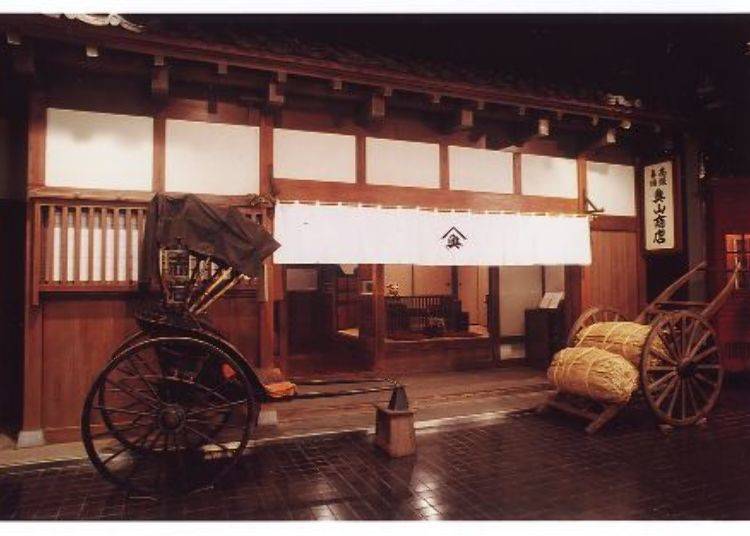
While the outside of the museum reflects a Taisho-period shitamachi building, the inside recreates various scenes from a Shitamachi area. Most of the materials in the museum are items that were used in daily life that were donated by residents of the local area.
Unlike other museums, the collection doesn't have high monetary value, but simply showcases items that were familiar and commonplace to the people at the time of the museum's opening. They are displayed in such a way that creates a more realistic idea of how they were used.
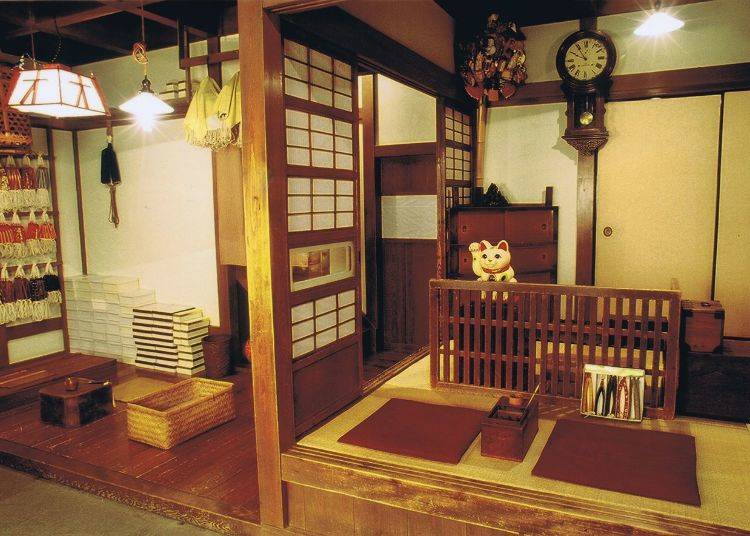
Inside there are realistic recreations of shitamachi houses, making you feel as though you've stepped into someone's actual room. From the workshop of a traditional sandal strap maker (the sandals being called geta, and the straps hanao), to the living room of a regular citizen in the economic boom of the 1950s, you get a real sense of what life was like.
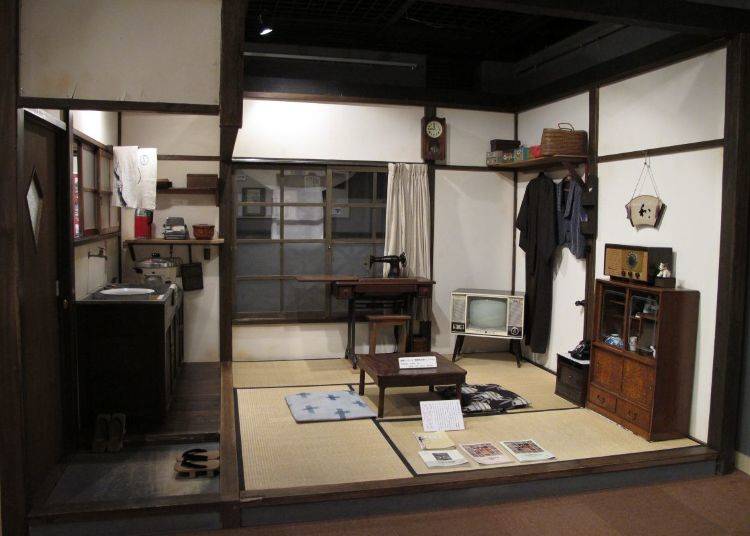
The museum makes a great stop after a walk around Ueno Park, or when you need a bit of shelter from the rain or sun, and have some time to learn about Japan's shitamachi culture.
Multilingual Support:
Website available in other languages auto-translate; Information for some exhibits in English with supplementary pamphlets
Health & Safety Measures:
Indoor disinfection measures taken; Sanitizer installed; Ventilation measures in place; Coin trays used; Plastic partitions installed; Staff wear masks
-
Shitamachi Museum台東区立下町風俗資料館
- Address 2-1 Uenokoen, Taito City, Tokyo 110-0007
・Hours: 9:30 a.m. – 4:30 p.m. (last admission 4:00 p.m.)
・Closed: Mondays
・TEL: 03-3823-7451
・Website: <a href="http://www.taitocity.net/zaidan/shitamachi/">http://www.taitocity.net/zaidan/shitamachi/</a>
Shops in Ueno
Hinoya One
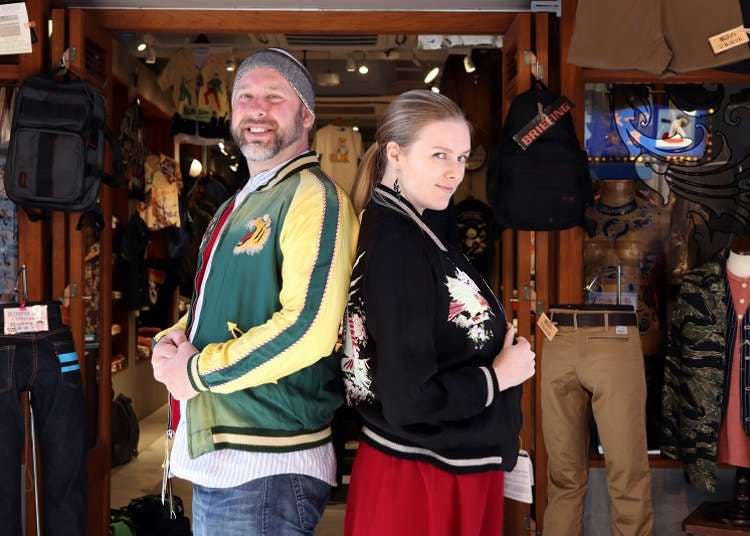
Hinoya One is a one-stop shop for all your souvenir jacket needs. The shop deals with countless products that were made using vintage machines manufactured around the time of the sukajan's birth, and there is a mind-boggling amount of materials, embroidery designs, zippers, and other small parts you can pick from.
Our first recommendation from Hinoya One is "Tailor Toyo Hinoya 70th Anniversary Commemorative Acetate Suka, Alaska x Japan Map" (49,500 yen, tax included). This is a custom-made limited edition model ordered from clothing specialist Toyo Enterprise for Hinoya's 70th anniversary. The jacket is designed to be reversible - another sukajan feature that makes it appealing to many. Timothy and Cassie are each showing off one side of the jacket in this photograph.
Learn more about Hinoya One and other sukajan shops in Ueno below!
Niki no Kashi
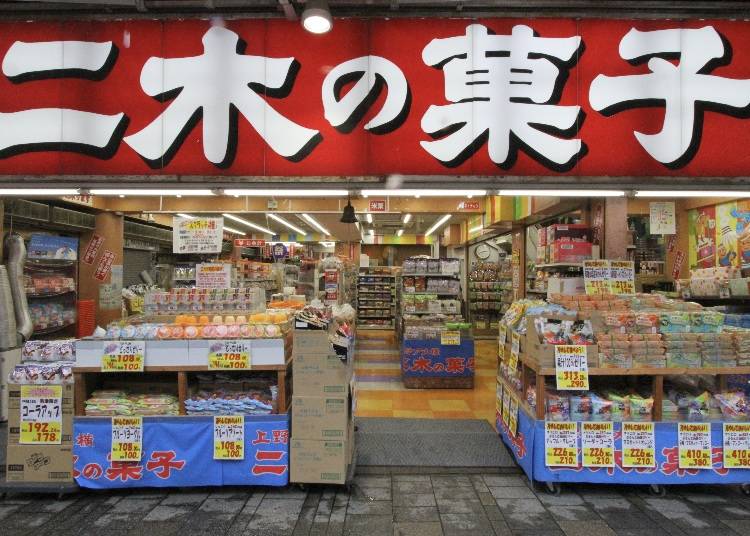
Niki no Kashi is a popular sweet and snack shop for locals and tourists alike, and one of the reasons for that is simply their huge variety!
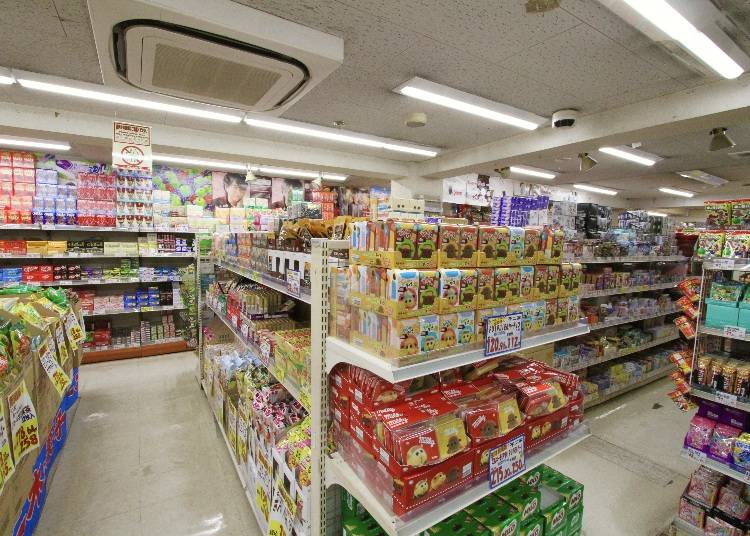
In the shop's name "niki" means "two trees" and "kashi" means "sweet" or "candy". This is simply due to the founder's name, which also meant "two trees". They originally set up the "Niki Shokuhin Kogyo Sho" in 1947 to produce and sell sweets, setting up shop in 1949.
Niki no Kashi prides themselves on having a wide variety of sweets, and once you step foot inside the shop, you'll realize that is no exaggeration. Every nook and cranny is packed full of sweets and snacks, some of which you might have a hard time finding elsewhere!
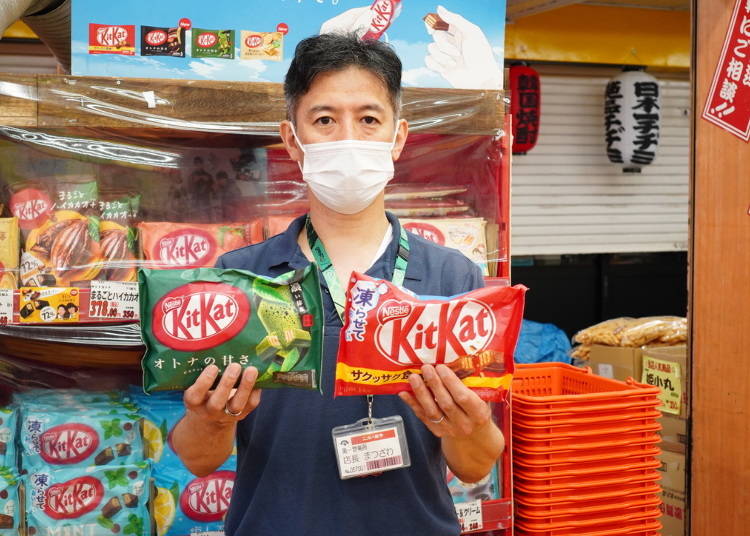
Speaking to Matsuzawa -san, the shop manager, I asked for his recommendations for first-timers. He said the KitKats, character snacks, and dagashi (penny candies) were popular choices.
While much of their candy is regularly stocked, they also change out some of their items with the seasons and trends. For example, you will find plenty of Halloween-themed sweets in October, or Christmas-themed treats around December.
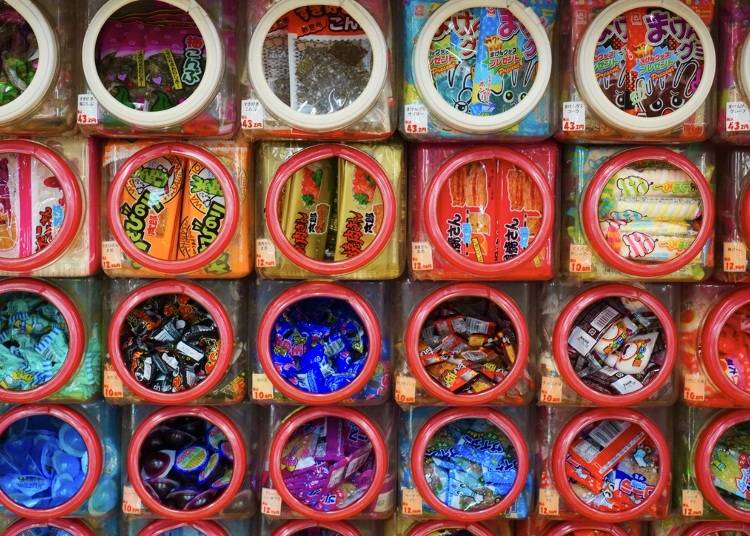
On the first floor, there is a huge selection of dagashi, starting from as little as 10 yen per item. So even with just 100 yen you can easily satisfy your sweet tooth!
If you want something more traditional, they have their Mukashigashi corner just before the dagashi. Mukashigashi means "the sweets of old", and features interesting creations you may have never seen before.
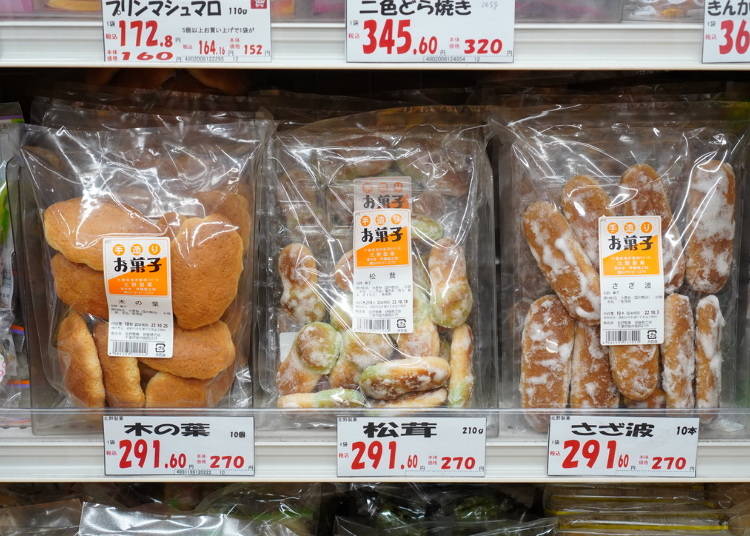
Here, from left to right, are "konoha", "matsutake", and "sazanami", which are all traditional takes on a sweet cracker or wafer.

For more western nostalgia, head to the second floor for PEZ and Haribo!

If you're a bit overwhelmed by all the sweets, there are also plenty of savory snacks, too. On the first floor, right by the entrance, there are two aisles packed with senbei, traditional rice crackers, and other dried snacks, like these tiny crabs. You can certainly get a bit adventurous in this aisle.
There are also fun creative items for kids, such as these mini create-a-donut sets, and various festival-inspired toys.
If there's something you can't find, it might be in their shop opposite, which has a bit more of a supermarket vibe, so make sure to check that out too!
Multilingual Support:
Website and social media available in other languages; Duty-free is supported; Credit cards are supported
Health & Safety Measures:
Indoor disinfection measures taken; Sanitizer installed; Ventilation measures in place; Coin trays used; Plastic partitions installed; Staff wear masks, gargle, wash hands regularly, and monitor body temperature; Entry declined to anyone who is feeling unwell
Restaurants and Cafes in Ueno
Usagiya Café
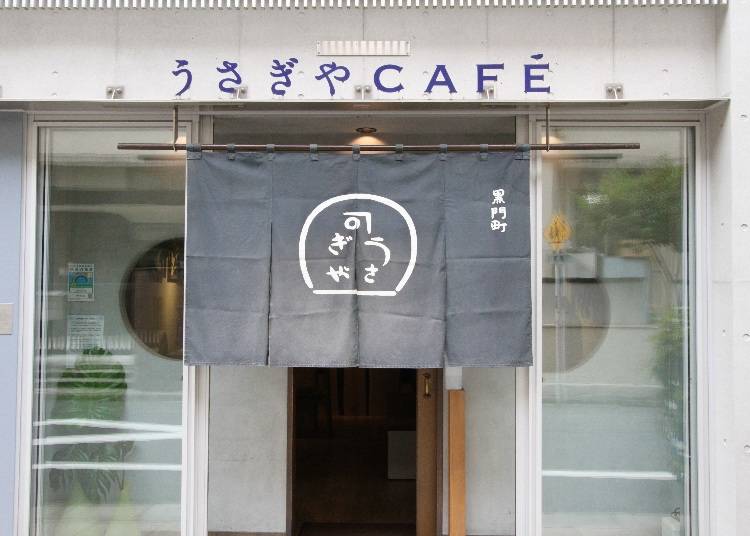
Tucked away from the busy main streets is the adorable (and delicious) Usagiya Café. The café was created by the owners of Usagiya, a well-known confectioner who has been making their own <@dorayaki|i@ in Ueno since 1913.
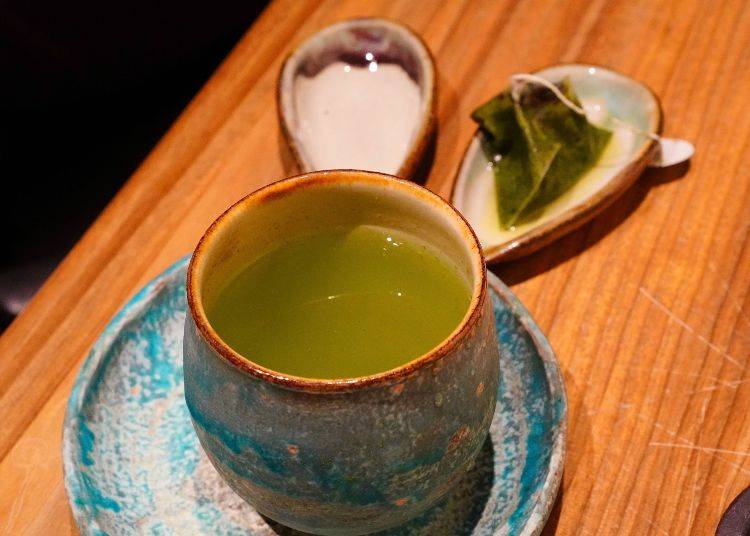
The "usagi" in Usagiya means "rabbit", and this was chosen as the name because the founder was born in the year of the rabbit. Coincidentally, Takuya Taniguchi, the 4th generation owner, was born in the year of the rabbit, too.
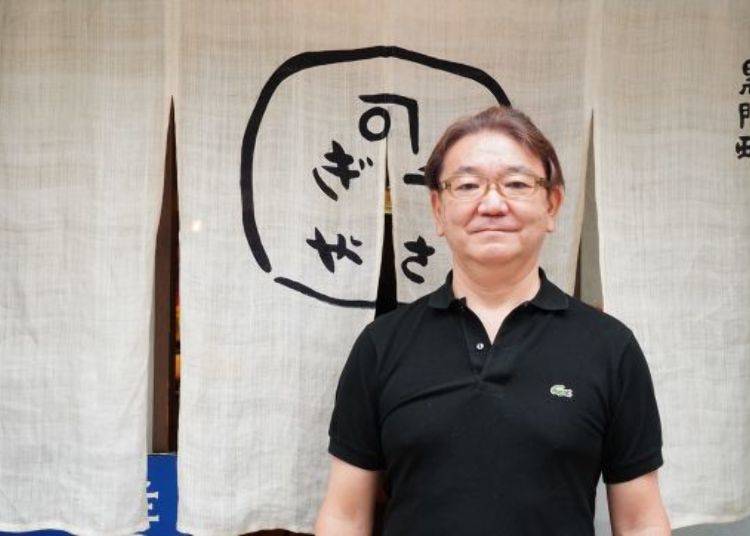
Taniguchi-san told us that the main focus of both their shop and café is their dorayaki, and in particular the anko that is sandwiched within. Anko is a mildly sweet red bean paste, and a dorayaki is a traditional Japanese sweet snack, made of pancake-like outer layers surrounding the anko. Typically, dorayaki are served cold and pre-packaged, but Usagiya prides themselves on making their very own anko in-house, so they serve the dorayaki warm and fresh, which keeps them soft and delicious.

Usagiya Café has a Hawaiian vibe to it, inspired by how Japanese expats in Hawaii decorate their cafes, and it gives the café a distinctly relaxed atmosphere.
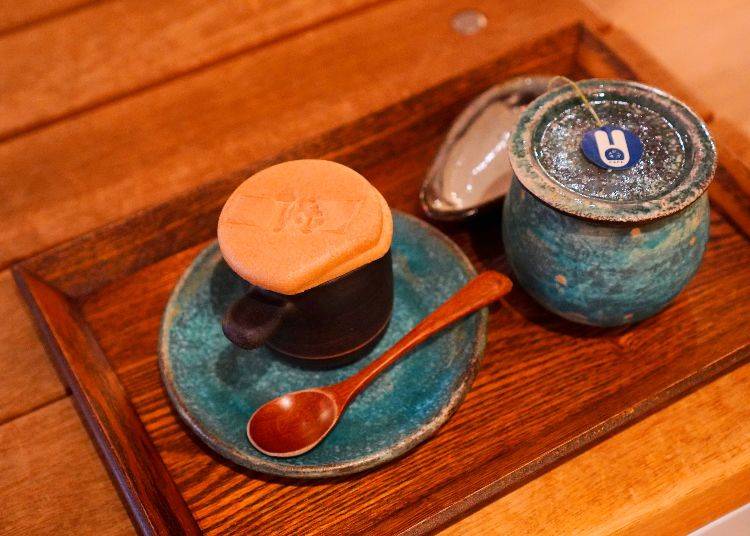
The menu offers a number of tasty-looking desserts, such as their kakigori (shaved ice) or Usa Shiruko (sweet bean porridge) options, but having heard so much about their famous dorayaki, I just had to try their "Usa Dora French Yaki" (900 yen). Let me tell you, I was not disappointed.

The dorayaki is cooked French toast style, and is cooked in plenty of butter, and sprinkled with soft powdered sugar. It was incredibly soft, with no crunch or hardness to detract from the flavors. It was eggy and sweet, and is exactly what I would want from a Japanese fusion brunch.
I had it with a cup of Sayama tea, a green tea produced in Saitama. It's rare that a cup of green tea stands out to me, but here their tea was wonderfully refreshing without any bitterness. If you love it as much as I do you can buy some teabags to take home, too!
Usagiya Café has a few seasonal items, but their mainstays are certainly the highlight, with kakigori on offer all year round. This is a fun way to try out traditional Japanese sweets, as they are made with familiar western flavors such as butter and cheese.
Multilingual Support:
Menu available in English; Images printed on menu; Limited English spoken
Health & Safety Measures:
Indoor disinfection measures taken; Sanitizer installed; Ventilation measures in place; Coin trays used; Plastic partitions installed; Staff wear masks, gargle, wash hands regularly, and monitor body temperature; Entry declined to anyone who is feeling unwell; Guests requested to wear masks; Disinfected after each guest leaves
-
Usagiya CaféうさぎやCAFÉ
- Address 1-17-5 Ueno, Taito-ku, Tokyo 110-0005
・Hours: 9:00 a.m. - 6:00 p.m.
・Closed: Wednesdays
・Phone: 03-6240-1561
・Website: <a href="http://usagiya-cafe.com/">http://usagiya-cafe.com/</a>
Hard Rock Cafe Uyeno-Eki Tokyo
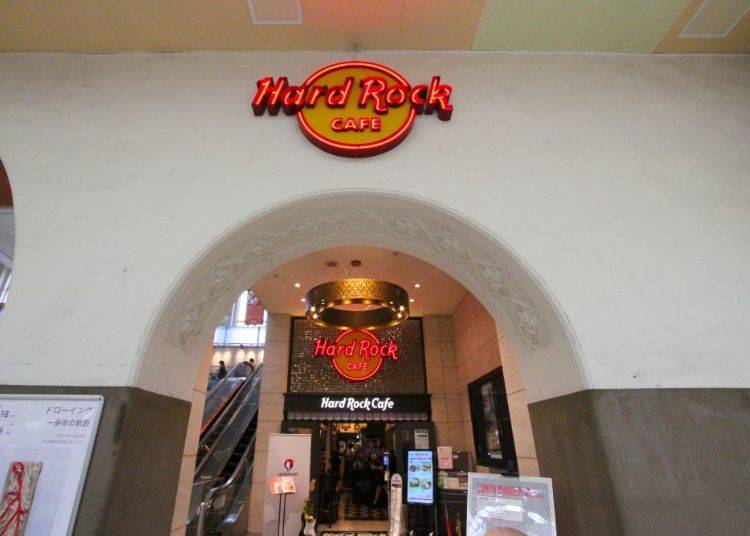
The Hard Rock Cafe is one of the most famous proper burger restaurants worldwide, and Tokyo is lucky enough to have two. One is in Roppongi, and the other is here in Ueno.
The Hard Rock Cafe Uyeno-Eki Tokyo is incredibly easy to get to, as it is located within the Ueno station complex, a short walk from the Central Ticket Gate.

The main restaurant entrance is under the arch, with its signature Hard Rock Cafe sign in glittering lights. The restaurant has all the classic hits playing, and the walls are, of course, decorated with classic rock relics, such as the wig worn by Tina Turner, or a signed flute from Jethro Tull's Ian Anderson.
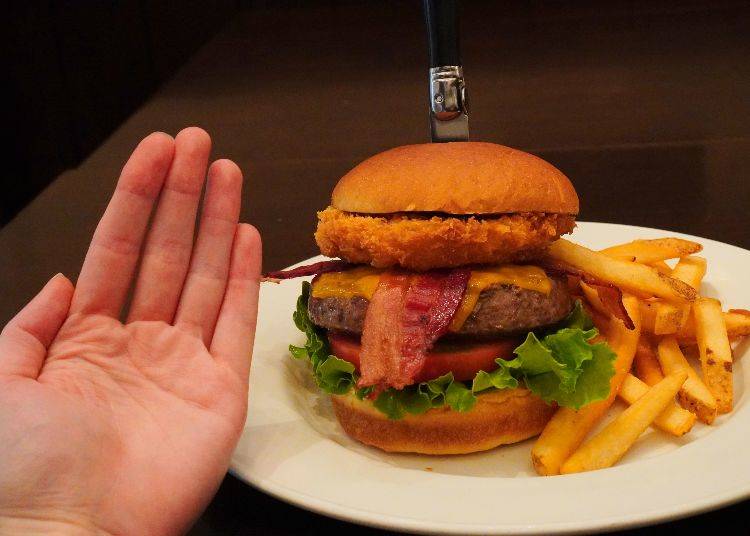
Hankering for my first decent burger in a while, I ordered their Original Legendary Burger (2,680 yen). The burger was stacked high with bacon, cheddar cheese, and a thick onion ring.

The brioche buns were soft and sweet, and the crispy bacon was a welcome addition in this often bacon-less land. The burger patty and bacon are cooked with original Hard Rock seasoning, and the burger is cooked on charcoal, giving it the flavor that sets it apart. The skin-on fries were crispy on the outside and soft in the middle, rounding out an overall satisfying meal.
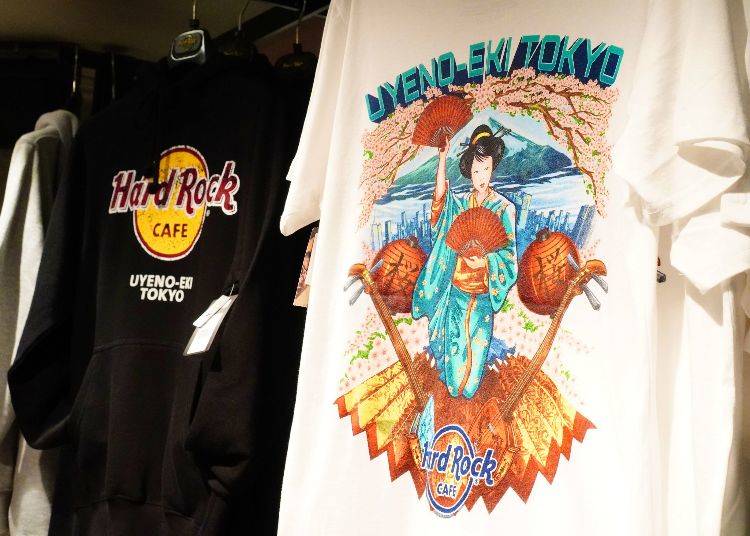
Of course, it's not just the food that the Hard Rock Cafe is good for – did you really visit if you didn't get a souvenir? The small shop next door is packed with Japan-inspired designs, like this T-shirt featuring a kimono-clad woman in front of the iconic Mt. Fuji. There are so many toys, tees, and keychains to choose from, it's hard not to buy it all!
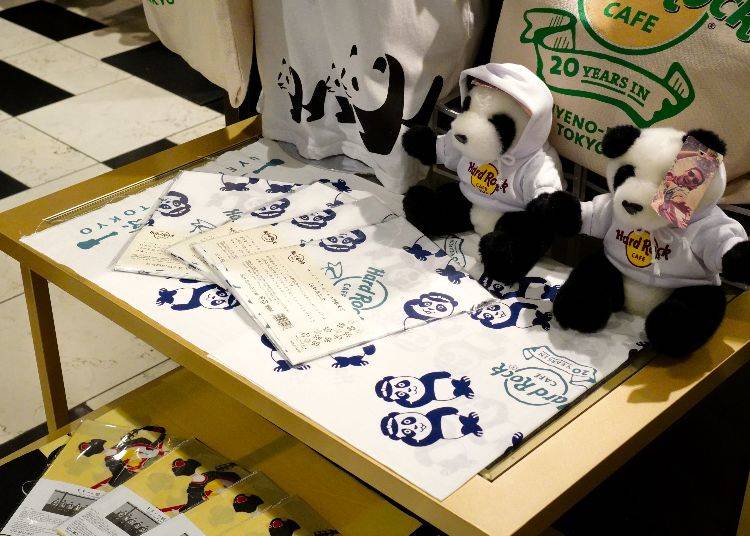
Given that the Uyeno-Eki branch opened in 2002, to celebrate their 20th anniversary, they collaborated with Ueno Zoo to produce panda-themed souvenirs, such as this adorable panda tenugui (a thin decorative "towel").
Multilingual Support:
Website available in multiple languages; Staff speak multiple languages; Menu in English; Multilingual support (telephone, online reservation); Duty free support; Discounts exclusively for overseas visitors; Free Wi-Fi; Credit card payment support (including UnionPay); Existence of smoke separation and smoking space; Wheelchair / strollers allowed; Support for dietary and religious requirements; Support for contactless payment; Response to SDGs (environmental efforts, etc.)
Health & Safety Measures:
Indoor disinfection measures taken; Sanitizer installed; Disinfected after each guest leaves
Ventilation measures in place; Coin trays used; Plastic partitions installed; Staff wear masks, gargle, wash hands regularly, and monitor body temperature; Limited capacity/increased space between seats; Restricted admission, reservation system in place; Entry declined to anyone who is feeling unwell; Guests requested to wear masks and conduct temperature checks
-
Hard Rock Cafe Uyeno-Eki TokyoHard Rock Cafe Uyeno-Eki Tokyo
- Address Atre, 1F, 7 Chome-1-1 Ueno, Taito City, Tokyo 110-0005
・Hours: 9:00 a.m. – 9:00 p.m. daily
・Phone: 03-5826-5821
・Website: <a href="https://www.hardrockcafe.com/location/tokyo-uyeno-eki/">https://www.hardrockcafe.com/location/tokyo-uyeno-eki/</a>
Egg Baby Café
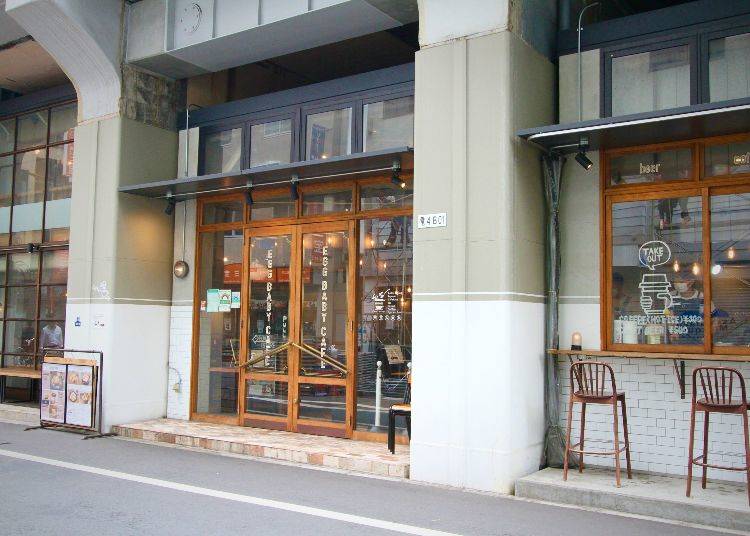
Egg Baby Café is a stylish space specializing in... eggs!
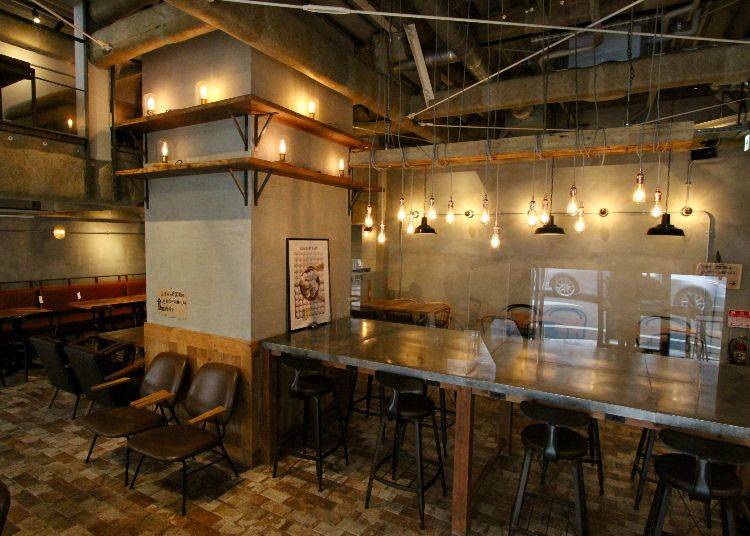
Taking their inspiration from New York eateries, the Egg Baby Café opens its doors at 10am to offer their delicious egg creations to the world. They take particular pride in their soft-boiled egg sandwich that highlights the delicious eggy flavors.

Of course, I had to try their pride and joy, and it was a great start to the day. The “Egg Baby sand with French fries” (900 yen) is unlike regular egg mayo sandwiches in many ways. For one thing, the sandwich is made with both egg mayo and boiled eggs, totaling four eggs in each sandwich. The soft-boiled eggs come from Iwate Prefecture, which are good for that vibrant orange-yellow yolk.
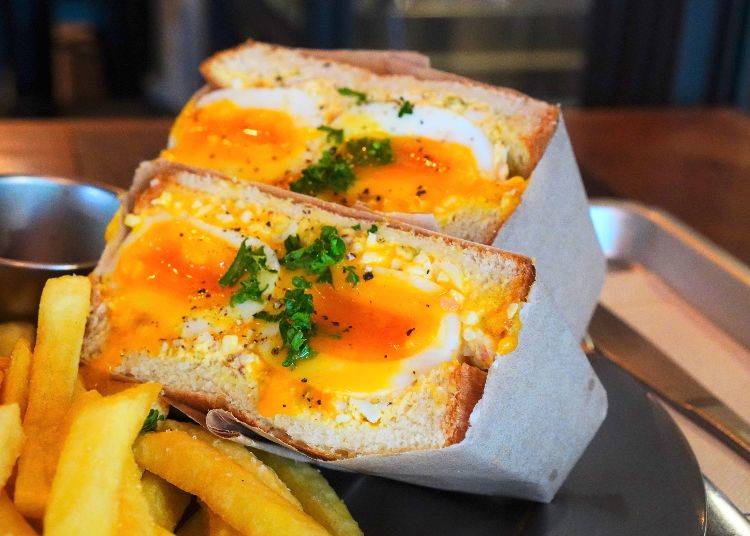
Those eggs are surrounded by an egg mayo mixture made with bacon. The bacon brings out a rich and salty umami flavor that is well seasoned. All of that is sandwiched between two slices of homemade bread, with a nice texture that offers a break from the sometimes overly-soft sandwich bread you might find elsewhere in Japan.
The chips are fresh and crisp on the outside, and nicely salted, so there is no need for extra seasoning. The salad is simple, with a vinegary dressing and some sweetness from the carrots and sultanas.
It's not just the egg sandwich that people rave about, though. Egg Baby Café offers up various egg-based dishes alongside refreshing teas, juices, and alcoholic drinks.
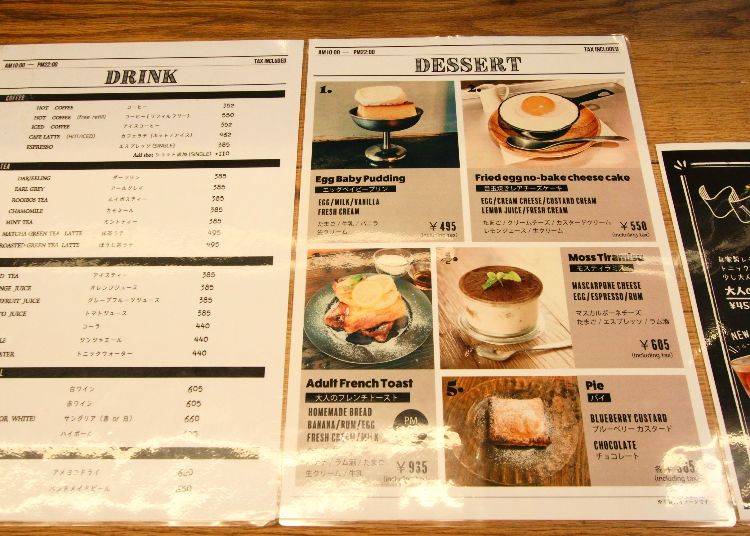
Throughout the year, different menu items pop up now and then, such as the summer Mango Soda, or their spring Sakura Milk Tea. But their Egg Baby Sandwich and Egg Baby Pudding are regulars that aren't going anywhere.
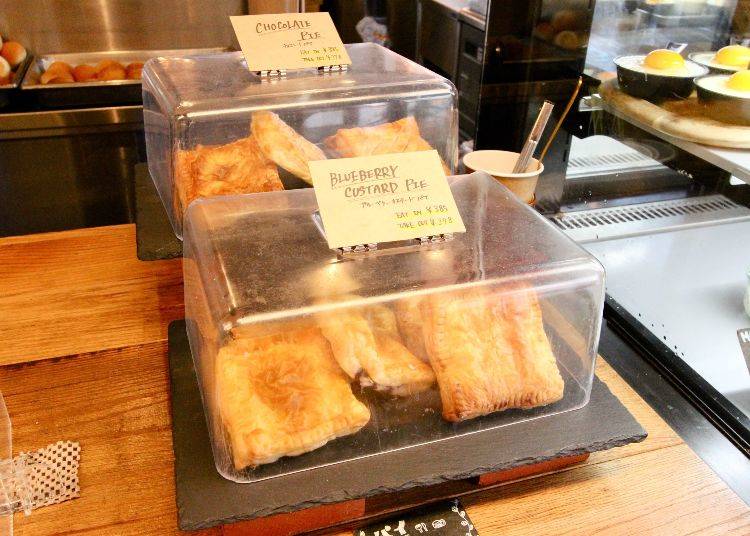
At the counter, you can see their dessert lineup, as well as some homemade pies. But if you don't have time to sit down on your Ueno travels, don't worry, they do takeout too!
Multilingual Support:
Menu available in English; Menu has images
Health & Safety Measures:
Sanitizer installed; Disinfected after each guest leaves; Ventilation measures in place; Coin trays used; Plastic partitions installed; Staff wear masks, gargle, wash hands regularly, and monitor body temperature
-
Egg Baby Cafeエッグベイビーカフェ
- Address 5 Chome-10-9 Ueno, Taito City, Tokyo 110-0005
・Hours: Open daily 10:00 a.m. – 10:00 p.m.
・Phone: 03-6823-1155
How to Get to Ueno
The easiest way to get to Ueno is via the JR Yamanote Line, or by using the Tokyo Metro Ginza or Hibiya lines.
From Tokyo Station, it takes under 10 minutes on the JR Yamanote Line. From Shibuya Station, the trip takes around half an hour and is accessible via the JR Yamanote Line or the Tokyo Metro Ginza Line, with the Ginza Line being slightly faster.
Remember that the JR line exits and the metro exits are slightly different at Ueno Station. From the metro, look for signs to The National Museum of Western Art for the park side, or Tokyo Marui for the shop and restaurant side. From the JR, look for the Central Ticket Gate for the shop side, and Park Gate for the park side.
Staying in Ueno
Ueno is a perfect place to base yourself while in Tokyo. Here are some of our recommended places to stay.
-
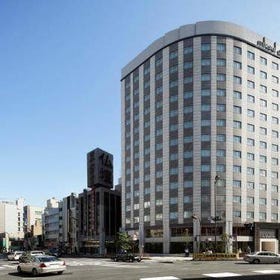 Mitsui Garden Hotel Ueno
Mitsui Garden Hotel Ueno -
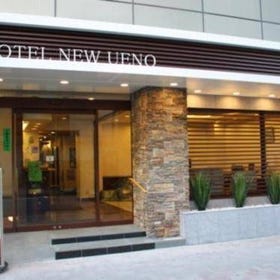 Hotel New Ueno
Hotel New Ueno -
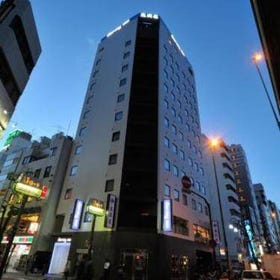 Dormy Inn Ueno Okachimachi
Dormy Inn Ueno Okachimachi
Cassandra Lord is a British journalist specialising in food, travel, and culture, and has been in Japan for five years after studying Japanese at Edinburgh University for four. With a year of experience as co-editor for LIVE JAPAN, Cassandra has since transitioned to freelance writing, contributing to a variety of platforms including The Japan Times and Tokyo Weekender. During her time in Japan she has visited 25 prefectures, with a goal to eventually visit all 47. She also manages her own YouTube channel, "Cassandra Lord", which is dedicated to all things related to Japanese culinary culture. She also works as a translator and photographer.
- Area
- Category
*Prices and options mentioned are subject to change.
*Unless stated otherwise, all prices include tax.
Popular Tours & Activitiess
Recommended places for you
-

This Winter, Godzilla Takes Over Haneda Airport
by: Guest Contributor
-

First Japan Cherry Blossom 2026 Forecast Announced! Here's When & Where to See Sakura in Japan
-

Jujutsu Kaisen Takes Over JR East With a Wrapped Shinkansen This Winter
by: Guest Contributor
-

Japan’s Shinkansen Is About to Change Travel in an Unexpected Way
by: Guest Contributor
-

Strawberries, Style, and Tokyo’s Coolest Neighborhood: Winter Afternoon Tea in Kichijoji
by: Guest Contributor
-

How to Get Don Quijote's Exclusive 2025-2026 Winter Gift (+Tax-Free Savings)
Inspiration for Accommodations
-

Enjoy Mt. Fuji from the Comfort of Your Room! Recommended Ryokan with Mt. Fuji View
-

Stay Near the Cherry Blossoms! Hotels for Cherry Blossom Viewing in Tokyo
-

Family-Friendly Hotels with Free Shuttle to Disneyland: Convenient Access for a Magical Stay
-

Top Ranked Hakone Hotels with Mt. Fuji View: Enjoy Stunning Scenery from Your Private Space
-

Convenient Tokyo Hotels with Airport Shuttle: Ideal for Families and Heavy Luggage
-

Stunning Tokyo Tower View Hotels: Enjoy Spectacular Scenery from Your Private Space
-

Convenient Asakusa Hotels with Kitchens: Ideal for Extended Family Visits
-

Experience Luxury: Hakone's 10 Best Five-Star Accommodations
-

Enjoy Mt. Fuji Autumn Leaves! Top Hotels Near the Popular Autumn Leaves Corridor
-

Experience Hakone Fall Foliage from Your Room with Stunning Views
-

What are Tokyo's Must-See Scenic Spots? Surprising Unusual Spots Chosen by 10 Foreigners
by: Ran Tanaka
-

'So Much Freedom!' Locals Recommend Tokyo's Best Neighborhoods & Hidden Gems
-

Meiji Shrine (Meiji Jingu): Exploring the Sacred Sanctuary of Peace in Bustling Tokyo
-

Why These 20 Japanese Cities are Blowing up on Instagram
by: Lucio Maurizi
-

Secrets to Shopping in Japan: Guide to Annual Sales in Japan & Where to Shop
by: Miyu Shimada
-

Tokyo Day Pass: 10 of the Coolest Spots in Tokyo You Don't Yet Know (and How to Get There on a Budget!)
by: Lucio Maurizi
- #best ramen tokyo
- #what to buy in ameyoko
- #what to bring to japan
- #new years in tokyo
- #best izakaya shinjuku
- #things to do tokyo
- #japanese nail trends
- #what to do in odaiba
- #onsen tattoo friendly tokyo
- #daiso
- #best sushi ginza
- #japanese convenience store snacks
- #best yakiniku shibuya
- #japanese fashion culture
- #best japanese soft drinks















